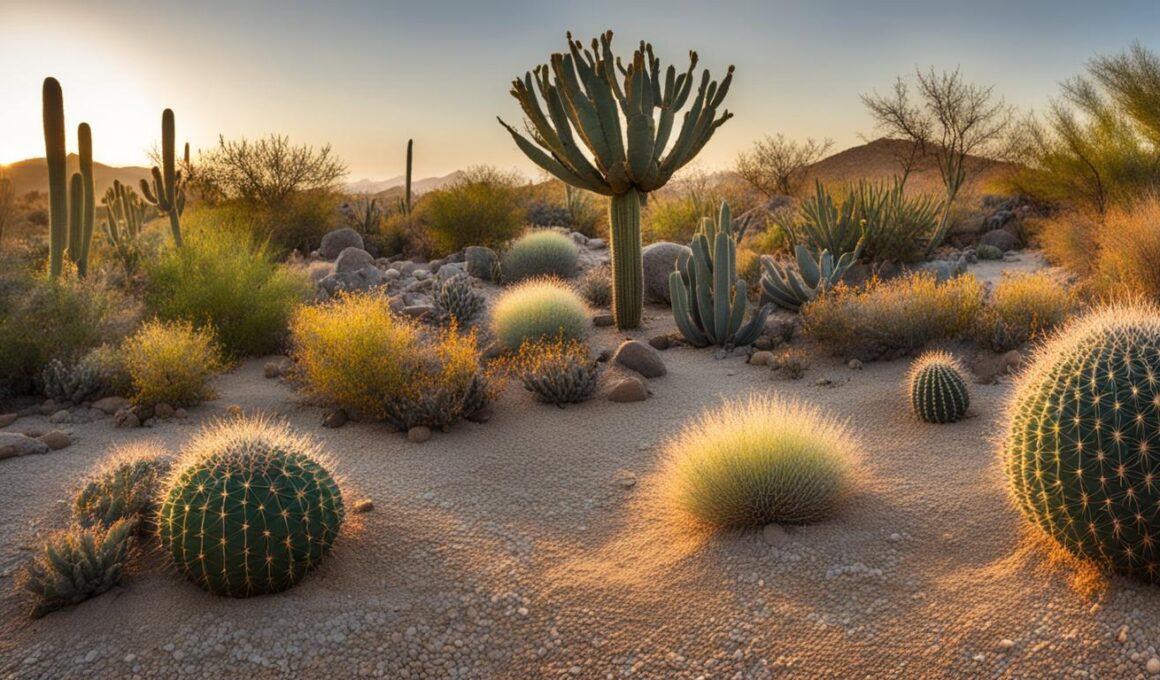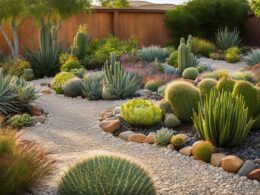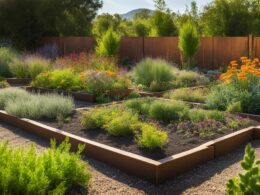Are you looking for a gardening solution that is environmentally conscious and cost-effective? Look no further than xeriscaping. With its focus on water conservation and drought-resistant plants, xeriscaping offers an ideal way to create a lush and diverse garden while minimizing water usage and maintenance needs.
By understanding the principles, benefits, and essentials of xeriscaping, you can transform your garden into a visually appealing and eco-friendly landscape. In this article, we will delve into the world of xeriscaping and explore why it is a smart choice for sustainable gardening.
Key Takeaways:
- Xeriscaping is a cost-effective and eco-friendly gardening method that conserves water.
- By strategically selecting drought-resistant plants and improving soil, you can create a beautiful landscape with minimal water usage.
- Xeriscaping offers benefits such as water conservation, reduced maintenance, and the creation of a wildlife habitat in your garden.
- Proper planning and maintenance are essential for the success of your xeriscape.
- Xeriscaping not only benefits the environment but also saves you money by reducing water bills and landscaping expenses.
Understanding Xeriscaping and Its Benefits
Xeriscaping is a landscaping method that has gained popularity in recent years due to its numerous benefits. Originating in the 1970s as a way to conserve water in arid regions, xeriscaping has evolved into a smart choice for homeowners looking for cost-effective and environmentally conscious gardening solutions.
By implementing xeriscaping principles, you can minimize water usage while still creating a lush and diverse garden. The main goal of xeriscaping is to strategically select plants that are drought-resistant and well-adapted to your climate. This not only reduces the need for watering but also promotes the growth of resilient plants that can thrive in challenging conditions.
There are several benefits to embracing xeriscaping in your garden. Firstly, it conserves water by significantly reducing consumption compared to traditional lawns and gardens. Depending on your location, xeriscaping can reduce water usage by as much as 70-80%. This not only helps to alleviate strain on local water supplies but also significantly lowers your water bills.
“Xeriscaping conserves water by significantly reducing consumption compared to traditional lawns and gardens.”
Furthermore, xeriscaping is a low-maintenance gardening option. With the proper plant selection and implementation of efficient irrigation methods, you can minimize the time and effort required for upkeep. This allows you to spend more time enjoying your garden rather than constantly tending to it.
Lastly, xeriscaping creates a welcoming habitat for local wildlife and important pollinators. By incorporating native plants into your landscape, you provide food, shelter, and nesting opportunities for birds, butterflies, and other beneficial insects. This helps to support biodiversity and contributes to the overall health of your ecosystem.
The Benefits of Xeriscaping:
- Conserves water
- Reduces water bills
- Requires less maintenance
- Promotes biodiversity
- Supports local wildlife and pollinators
With a clear understanding of xeriscaping and its benefits, you can make an informed decision about implementing this sustainable gardening method in your own backyard. By conserving water, reducing maintenance needs, and creating a thriving ecosystem, xeriscaping offers a smart and eco-friendly solution for homeowners.
Getting Started with Xeriscaping
If you’re ready to transform your garden into a beautiful and water-efficient landscape, getting started with xeriscaping is easier than you might think. By following a few simple tips and guidelines, you can create a low-maintenance, environmentally friendly garden that thrives in your specific climate.
Assess Your Landscape
Before diving into xeriscaping, take some time to evaluate your landscape. Consider the amount of sunlight and shade in different areas, the type of soil you have, and the existing plants in your garden. This assessment will help you make informed decisions when it comes to choosing the right plants and designing your xeriscape.
Choose Drought-Resistant Plants
One of the key principles of xeriscaping is selecting plants that are well-suited to your climate and require minimal water. Native and drought-resistant plants are excellent choices as they have adapted to local conditions and can thrive with less irrigation. Research the plants that are native to your region and incorporate them into your xeriscape for a more sustainable and resilient garden.
Improve Your Soil and Water Efficiently
Preparing your soil is crucial for the success of your xeriscape. Test the soil to determine its composition and make necessary amendments, such as adding organic matter to improve its structure and fertility. Additionally, consider incorporating efficient irrigation methods like drip systems or soaker hoses to minimize water waste and ensure that your plants receive water right at their roots.
With these tips, you’re well on your way to getting started with xeriscaping. By evaluating your landscape, selecting the right plants, improving your soil, and optimizing water usage, you’ll be able to create a thriving and sustainable xeriscape that not only saves water but also adds beauty to your outdoor space.
The Benefits of Xeriscaping Your Salt Lake City Garden
When it comes to gardening in the arid climate of Salt Lake City, xeriscaping is more than just a trendy landscaping choice – it’s a smart and practical solution. By embracing xeriscaping principles, you can enjoy a range of benefits for both your garden and the environment.
1. Water Conservation: Xeriscaping can significantly reduce water consumption, conserving up to 70-80% compared to traditional lawns and gardens. In a region where water resources are limited, this is particularly important. By choosing drought-resistant plants and implementing efficient irrigation methods, you can minimize water waste and help alleviate strain on local water supplies.
2. Reduced Maintenance: Say goodbye to endless hours spent mowing, watering, and fertilizing your garden. Xeriscaping requires less maintenance compared to traditional landscaping, saving you time, effort, and money. With carefully selected plants and strategic design, your xeriscape can thrive with minimal intervention.
3. Financial Savings: Xeriscaping can lead to significant long-term cost savings. By reducing your water consumption, you’ll see a noticeable decrease in your water bills. Additionally, xeriscaping can decrease your lawn care expenses, as the need for mowing, fertilizers, and pesticides is greatly reduced.
4. Habitat Creation: By opting for xeriscaping, you can create a welcoming and sustainable habitat for local wildlife and important pollinators. Native plants attract birds, butterflies, bees, and other beneficial insects, supporting biodiversity and contributing to the overall health of your garden ecosystem.
Practical Tips for Successful Xeriscaping
Xeriscaping can be a rewarding and sustainable way to create a beautiful garden while conserving water. To ensure successful xeriscaping and maximize the benefits, here are some practical tips and strategies:
- Start with proper soil preparation: Test your soil to understand its composition and pH level. Amend it with organic matter like compost to improve its structure, water retention, and nutrient availability.
- Choose drought-tolerant and native plants: Select plants that are well-adapted to your climate and require minimal water. Native plants are naturally suited to your region’s conditions and typically have lower water requirements.
- Optimize water usage: Install efficient irrigation systems such as drip irrigation or soaker hoses to deliver water directly to the plant’s roots. Water deeply and infrequently to encourage deep root growth and reduce evaporation.
- Incorporate hardscaping elements: Integrate pathways, rock gardens, or decorative elements like gravel or pebbles to add visual interest and reduce the area that needs watering or maintenance.
Additionally, here are some key strategies to keep in mind for successful xeriscaping:
- Mulch around plants: Apply organic mulch like wood chips or straw around plants to conserve moisture, suppress weed growth, and regulate soil temperature.
- Practice regular maintenance: Keep your xeriscape garden healthy by regularly pruning, weeding, and monitoring for pests or diseases. Remove any dead or damaged plants to maintain the overall aesthetics.
- Consider layering and grouping plants: Grouping plants with similar watering needs and layering them based on their height and sun requirements can help create microclimates within your garden and reduce water usage.
Remember:
“Xeriscaping is all about strategic planning, plant selection, and efficient water management. By implementing these practical tips and strategies, you can create a thriving and visually appealing xeriscape garden that thrives in your region’s conditions while minimizing water usage and maintenance needs.”
With these practical tips and strategies, you can create a successful xeriscape garden that not only saves water but also adds beauty to your landscape. Implementing these practices will help you achieve an environmentally friendly and low-maintenance garden that is both cost-effective and sustainable.
Environmental and Financial Benefits of Xeriscaping
Xeriscaping offers numerous environmental advantages that make it a sustainable choice for gardening. By implementing xeriscaping principles, you contribute to water conservation efforts. Xeriscaping significantly reduces water usage compared to traditional lawns and gardens, helping to alleviate strain on local water supplies. This method also minimizes the need for chemical fertilizers and pesticides, reducing potentially harmful substances from entering the environment.
Moreover, xeriscaping promotes biodiversity by creating a welcoming habitat for local wildlife and important pollinators. Drought-tolerant plants and native species attract a variety of birds, butterflies, and other beneficial insects, enhancing the overall ecological balance of your garden.
“Xeriscaping conserves water, reduces chemical usage, supports wildlife, and minimizes energy consumption and pollution.”
Financially, xeriscaping offers significant benefits as well. By reducing water consumption, xeriscaping leads to lower water bills, especially in regions with high water costs. Additionally, xeriscaped gardens require minimal maintenance compared to traditional landscapes, resulting in reduced landscaping expenses. The savings in both water bills and maintenance costs can add up over time, providing long-term financial benefits for homeowners.
The financial benefits of xeriscaping include:
- Lower water bills
- Reduced landscaping maintenance costs
- Potential increase in property value
Furthermore, some local governments offer rebates and incentives for homeowners who adopt xeriscaping practices. These programs can provide additional financial support and encourage more people to embrace water-wise gardening methods, contributing to broader environmental conservation efforts.
Is Xeriscaping More Cost-Effective and Sustainable Than Traditional Gardening?
When deciding between xeriscaping versus traditional gardening, the cost-effectiveness and sustainability of xeriscaping become evident. With its focus on drought-resistant plants and minimal water usage, xeriscaping can save money on water bills and reduce environmental impact. In the long run, xeriscaping proves to be a more sustainable choice.
Key Principles of Xeriscaping and Its Drawbacks
Xeriscaping, as a sustainable gardening method, is guided by key principles that form the foundation of a water-wise garden. These principles include proper planning and design, soil improvements, efficient irrigation, limited turf use, mulching, choosing drought-tolerant plants, and regular maintenance.
Proper planning and design are essential to create a successful xeriscape. Evaluating your landscape, understanding sunlight, shade, soil type, and existing plants will help you make informed decisions and optimize resource utilization. By incorporating soil improvements such as adding organic matter, you can enhance soil structure and fertility, promoting healthy plant growth.
Efficient irrigation is another crucial principle of xeriscaping. By implementing drip systems or soaker hoses, you can deliver water directly to the root zones, minimizing evaporation and runoff. Limiting turf use and incorporating hardscaping elements, such as pathways and rock gardens, reduces water-intensive areas and decreases maintenance requirements.
While xeriscaping offers numerous benefits, it’s essential to consider potential drawbacks. Some individuals may find that xeriscaping reduces space for recreational activities, such as traditional lawn games. Additionally, upfront installation costs, including purchasing drought-tolerant plants and implementing efficient irrigation systems, may be higher compared to conventional gardening methods. Furthermore, xeriscapes require regular maintenance, including pruning, weeding, and monitoring, to ensure the health and longevity of the landscape.
Key Principles of Xeriscaping:
- Proper planning and design
- Soil improvements
- Efficient irrigation
- Limited turf use
- Mulching
- Choosing drought-tolerant plants
- Regular maintenance
“Xeriscaping offers a water-wise approach to gardening, but it’s important to consider trade-offs such as reduced space for recreational activities and additional upfront and ongoing costs.”
How Does Xeriscaping Contribute to Cost-Effective and Sustainable Gardening?
Xeriscaping is a sustainable landscaping method that reduces water usage and maintenance costs. By following soil preparation xeriscaping tips, such as using native plants and mulch, gardeners can create a water-efficient and low-maintenance garden. This innovative approach contributes to cost-effective and sustainable gardening practices.
How Does Nutrient Management Contribute to Cost-Effective Sustainable Gardening in Xeriscaping?
Nutrient management in xeriscape landscaping plays a crucial role in cost-effective sustainable gardening. By carefully monitoring and controlling the amount of nutrients used in xeriscaping, gardeners can achieve healthy plant growth while minimizing waste and reducing the need for costly chemical inputs. This approach promotes long-term environmental sustainability.
Conclusion
In conclusion, xeriscaping is a smart choice for cost-effective and sustainable gardening, particularly in water-scarce regions like Salt Lake City. By incorporating the principles and tips discussed in this article, you can create a beautiful garden that not only conserves water but also promotes biodiversity and enhances the value of your property.
Xeriscaping contributes to a greener future by minimizing water consumption and reducing environmental impact. With its low-maintenance nature, you’ll have more time to enjoy your garden without the constant need for watering and maintenance.
So, if you’re looking to create a visually appealing and eco-friendly landscape, consider embracing xeriscaping. With its emphasis on water conservation, plant selection, and efficient irrigation, xeriscaping allows you to enjoy a stunning garden while being mindful of the environment and your wallet. So, start implementing xeriscaping practices today and reap the benefits for years to come.














